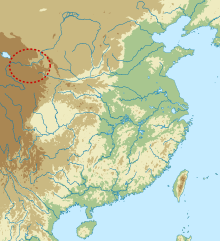Majiayao culture
 |
|||||||
| Geographical range | upper Yellow River | ||||||
|---|---|---|---|---|---|---|---|
| Period | Neolithic China | ||||||
| Dates | c. 3300 – c. 2000 BC | ||||||
| Followed by | Qijia culture | ||||||
| Chinese name | |||||||
| Simplified Chinese | 马家窑文化 | ||||||
| Traditional Chinese | 馬家窰文化 | ||||||
|
|||||||
| Transcriptions | |
|---|---|
| Standard Mandarin | |
| Hanyu Pinyin | Mǎjiāyáo Wénhuà |
The Majiayao culture was a group of Neolithic communities who lived primarily in the upper Yellow River region in eastern Gansu, eastern Qinghai and northern Sichuan, China. The culture existed from 3300 to 2000 BC. The Majiayao culture represents the first time that the Upper Yellow River region was widely occupied by agricultural communities and it is famous for its painted pottery, which is regarded as a peak of pottery manufacturing at that time.
The archaeological site was first found in 1924 near the village of Majiayao in Lintao County, Gansu by Swedish archaeologist Johan Gunnar Andersson, who considered it part of the Yangshao culture. Following the work of Xia Nai, the founder of modern archaeology in the People's Republic of China, it has since been considered a distinct culture, named after the original site. This culture developed from the middle Yangshao (Miaodigou) phase, through an intermediate Shilingxia phase. The culture is often divided into three phases: Majiayao (3300–2500 BC), Banshan (2500–2300 BC) and Machang (2300–2000 BC).
At the end of the third millennium BC, the Qijia culture succeeded the Majiayao culture at sites in three main geographic zones: eastern Gansu, central Gansu, and western Gansu/eastern Qinghai.
The most distinctive artifacts of the Majiayao culture are the painted pottery. During the Majiayao phase, potters decorated their wares with designs in black pigment featuring sweeping parallel lines and dots. Pottery of the Banshan phase is distinguished by curvilinear designs using both black and red paints. Machang-phase pottery is similar, but often not as carefully finished.
Majiayao phase
Banshan phase
Banshan phase
Machang phase
Machang phase
The manufacture of large amounts of painted pottery means there were professional craftsmen to produce it, which indicates the appearance of social division of labor.
...
Wikipedia
